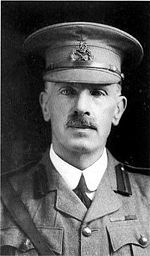15 May 1915
ANZAC - Life at Anzac reflected the drip-drip of casualties caused by the close quarter nature of the fighting. Everyone was at risk; rank or status gave no guarantee of protection. A small mistake in judging dead ground, or a second's hesitation in crossing a vulnerable spot could be fatal. Thus it could be no real surprise when Major-General Sir William Bridges was fatally wounded in Monash Valley on 15 May.
 Photograph: Major General Sir William Bridges, Headquarters, 1st Australian Division
Photograph: Major General Sir William Bridges, Headquarters, 1st Australian Division
Captain Horace Viney was on his way to the beach with a working party when he met Bridges coming up the gully to visit the headquarters of the 1st Light Horse Brigade in Monash Valley. As they were not part of his 1st Division there was no serious reason that Bridges could justify the dangers rashly incurred. Viney recalled their meeting:
"To negotiate Monash Gully safely one had to walk on alternate sides of it according to how the valley twisted and turned. Those who knew it could go up and down it comparatively safely by keeping under cover on one side until a twist in the gully exposed that side to the Turkish fire. It was then necessary to dart across the gully, a distance of from 10 to 20 yards, and gain shelter of the opposite bank. The Turks had marked down the crossing places and had them covered by snipers or machine guns. The worst crossing places had been protected by barricades, but they were neither high enough, nor long enough to give complete immunity. Having been up and down Monash Gully several times I had learned by painful experience just where the dangerous spots were. On several occasions I had beaten the Turkish snipers in my dashes across the gully only by inches and I consequently did not loiter unduly in crossing such places. One of the most dangerous was a distance of about 5 yards between the end of a barricade at the top end of the gully near a gravel pit, where an ambulance collecting post had been established, and a small spur on the opposite side of the gully". (Captain Horace Viney, 3rd Australian Light Horse, 1st Light Horse Brigade, NZ&A Division)
After a brief conversation Viney felt it beholden upon him to warn Bridges and his party of the dangers lurking higher up the gully.
"I impressed on them that they must keep on the right-hand side of the gully until they came to the ambulance collecting station and also that the only danger spot before they reached Brigade Headquarters, was the 5 yard dash across the gully from the end of the barricade there. If they crossed that at speed they would be quite safe. I was very emphatic about the necessity of crossing that spot quickly, and not only because of the machine gun the Turks had trained on it, but also because I had noticed that General Bridges was becoming less and less inclined to dash across the gully at those places where it was necessary to do so. I think that he was of the opinion that I had exaggerated the danger". (Captain Horace Viney)
Bridges reached the barricade and then talked for a while with the medical officers. After parting from them he went to cross the gully but in doing so he seems to have half-stopped and turned his head as if to speak again. A Turkish sniper seized his chance and Bridges was dreadfully wounded in the right thigh by a bullet cutting the major blood vessels. Only the immediate presence of medical assistance saved his life there and then, but he lost far too much blood to have much chance of survival. Amputation seemed the only chance, but his age, 54 years old, militated against that in the minds of his doctors. The result was to be expected: gangrene struck and Bridges took his by then inevitable fate with an admirable sangfroid, saying, "Anyway, I have commanded an Australian Division for nine months." He died aboard a hospital ship on 18 May.
"SOURCE:
H. G. Viney, Fatal Pause: General Sniped (Reveille, 1/4/1933), p.52
